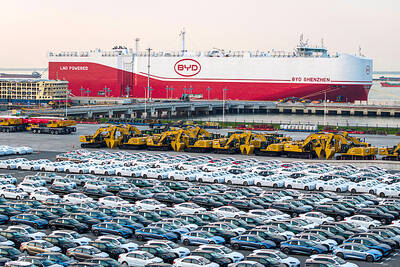For flat-panel televisions, the choice for years has been between plasma and LCD. This year consumers will be offered another choice, at least if they are prepared to spend big.
LG Electronics Inc says it is planning to sell a 55 inch television based on organic light--emitting diodes (OLEDs). The South Korean company is set to show off its new product at the International Consumer Electronics Show (CES) in Las Vegas, which starts on Tuesday next week.
Samsung Electronics Co, will reveal a nearly market-ready OLED television at the show, according to three people with knowledge of the matter. They spoke on condition of anonymity because Samsung has yet to make an announcement. Its Web site says that CES announcements will be made on Monday.
Tim Alessi, director of home electronics development at LG’s US arm, said its product would likely go on sale in the fourth quarter of the year. The company declined to reveal the price.
Paul Gagnon, an analyst at DisplaySearch, estimates that OLED televisions would start out above US$5,000.
The screen technology is already in use in high-end smartphones and provides deeply saturated colors and high contrast. However, it has proven difficult to make larger screens with consistent results. In late 2007, Sony Corp started selling an 11 inch OLED television for about US$2,500, but did not follow that up with a larger model.
Since then, LG and Samsung have shown prototype OLED televisions at the annual CES show, but have yet to unveil any marketing plans.
Apart from providing improved picture quality, OLED televisions can be very thin. LG’s set will be 4mm thick and weigh 7.5kg.

GROWING OWINGS: While Luxembourg and China swapped the top three spots, the US continued to be the largest exposure for Taiwan for the 41st consecutive quarter The US remained the largest debtor nation to Taiwan’s banking sector for the 41st consecutive quarter at the end of September, after local banks’ exposure to the US market rose more than 2 percent from three months earlier, the central bank said. Exposure to the US increased to US$198.896 billion, up US$4.026 billion, or 2.07 percent, from US$194.87 billion in the previous quarter, data released by the central bank showed on Friday. Of the increase, about US$1.4 billion came from banks’ investments in securitized products and interbank loans in the US, while another US$2.6 billion stemmed from trust assets, including mutual funds,

Micron Memory Taiwan Co (台灣美光), a subsidiary of US memorychip maker Micron Technology Inc, has been granted a NT$4.7 billion (US$149.5 million) subsidy under the Ministry of Economic Affairs A+ Corporate Innovation and R&D Enhancement program, the ministry said yesterday. The US memorychip maker’s program aims to back the development of high-performance and high-bandwidth memory chips with a total budget of NT$11.75 billion, the ministry said. Aside from the government funding, Micron is to inject the remaining investment of NT$7.06 billion as the company applied to participate the government’s Global Innovation Partnership Program to deepen technology cooperation, a ministry official told the

Taiwan Semiconductor Manufacturing Co (TSMC, 台積電), the world’s leading advanced chipmaker, officially began volume production of its 2-nanometer chips in the fourth quarter of this year, according to a recent update on the company’s Web site. The low-key announcement confirms that TSMC, the go-to chipmaker for artificial intelligence (AI) hardware providers Nvidia Corp and iPhone maker Apple Inc, met its original roadmap for the next-generation technology. Production is currently centered at Fab 22 in Kaohsiung, utilizing the company’s first-generation nanosheet transistor technology. The new architecture achieves “full-node strides in performance and power consumption,” TSMC said. The company described the 2nm process as

POTENTIAL demand: Tesla’s chance of reclaiming its leadership in EVs seems uncertain, but breakthrough in full self-driving could help boost sales, an analyst said Chinese auto giant BYD Co (比亞迪) is poised to surpass Tesla Inc as the world’s biggest electric vehicle (EV) company in annual sales. The two groups are expected to soon publish their final figures for this year, and based on sales data so far this year, there is almost no chance the US company led by CEO Elon Musk would retain its leadership position. As of the end of last month, BYD, which also produces hybrid vehicles, had sold 2.07 million EVs. Tesla, for its part, had sold 1.22 million by the end of September. Tesla’s September figures included a one-time boost in